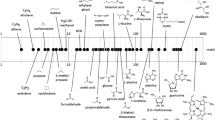Abstract
Although the origin of self-sustaining, autoreplicating systems capable of undergoing Darwinian evolution is still unknown, a research program based on the hypothesis of chemical and precellular evolution has provided a framework within which the abiotic synthesis of biochemical monomers and membrane components, the experimental study of replicative systems, and the interactions between different ribozymes and a potentially wide range of substrates including amino acids, can be incorporated into a coherent historical narrative of evolutionary events. The significance of mathematical models and computer-based simulations of autocatalytic cycles based on complexity theory to the study of the origin of life will be considerable enhanced when experimental evidence supporting them becomes available.
Preview
Unable to display preview. Download preview PDF.
Similar content being viewed by others
References
Bachmann, P. A., Luisi, P. L., and Lang, J. (1992) Nature 357: 57–59
Cairns-Smith, A. G. (1982) Genetic Takeover and the Mineral Origins of Life (Cambridge University Press, Cambridge)
Chyba, C. F., Thomas, P. J., and Sagan, C. (1990) Science 249: 366–373
Crick, F. H. C. (1968) Jour. Mol. Biol. 38, 367–379
de Duve, Ch. (1995) Vital Dust: life as a cosmic imperative (Harper Collins Publ. Co., New York)
Doudna, J. A. and Szostak, J. W. (1989) Nature 339: 519–522
Drobner, E., Huber, H., WÄchtershÄuser, G., Rose, D., and Stetter, K. O. (1990) Nature 346: 742–744
Eigen, M. and Schuster, P. (1978) Naturwissenschaften 65: 341–369
Ferris, J. P., Joshi, P. C., Edelson, E. H., and Lawless, J. M. (1978) J. Mol. Evol. 11: 293–311
Gesteland, R. F. and Atkins, J. F. (eds.) The RNA World (Cold Spring Harbor Laboratory Press, Cold Spring Harbor, NY)
Hong, J. I., Feng, Q., Rotello, V., and Rebek, J. Jr. (1992) Science 255: 848–850
Illangasekare, M., Sanchez, G., Nickles, T., and Yarus, M. (1995) Science 267: 643–647
Joyce, G. F., Schwartz, A. W., Orgel, L. E., and Miller, S. L. (1987) Proc. Natl. Acad. Sci. USA 84: 4398–4402
Kauffman, S. A. (1993) The Origins of Order: self-organization and selection in evolution (Oxford University Press, Oxford), 709 pp.
Lazcano, A. (1994) In S. Bengtson (ed), Early Life on Earth: Nobel Symposium No. 84 (Columbia University Press, New York), 60–69
Lazcano, A. and Miller, S. L. (1994) Jour. Mol. Evol. 39: 546–554
Majerfeld, I. and Yarus, M. (1994) Nature Struct. Biol. 1: 287–289
Miller, S. L. (1953) Science 117: 528–529
Morowitz, H. J. (1992) Beginnings of Cellular Life: metabolism recapitulates biogenesis (Yale University Press, New Haven)
Nielsen, P. E., Egholm, M., Berg, R. H., and Buchardt, O. (1991) Science 254: 1497–1500
Oparin, A. I. (1924) Proiskhodenie Zhisni (Moscovky Rabotchii, Moscow)
Oparin, A. I. (1938) The Origin of Life (MacMillan, New York)
Orgel, L. E. (1968) Jour. Mol. Biol. 38, 381–393
Orgel, L. E. (1987) Cold Spring Harbor Symp. Quant. Biol. 52, 9–16
Orgel, L. E. (1992) Nature 358, 203–209
Oro, J. (1960) Biochem. Biophys. Res. Comm. 2: 407–411
Oro, J., Miller, S. L., Lazcano, A. (1990) Annu. Rev. Earth Planet. Sci. 18: 317–356
Robertson, M. D. and Miller, S. L. (1995) Science (in press)
Schopf, J. W. (1993) Science 260: 640–646
WÄchtershÄuser, G. (1988) Microbiol. Rev. 52, 452–484
Woese, C. R. (1967) The Genetic Code: the molecular basis for gene expression (Harper and Row, New York)
Yarus, M. (1988) Biochemistry 28: 980–988
Ycas, M. (1955) Proc. Natl. Acad. Sci. USA 41: 714–716
Author information
Authors and Affiliations
Editor information
Rights and permissions
Copyright information
© 1995 Springer-Verlag Berlin Heidelberg
About this paper
Cite this paper
Lazcano, A. (1995). Prebiotic chemistry, artificial life, and complexity theory: What do they tell us about the origin of biological systems?. In: Morán, F., Moreno, A., Merelo, J.J., Chacón, P. (eds) Advances in Artificial Life. ECAL 1995. Lecture Notes in Computer Science, vol 929. Springer, Berlin, Heidelberg. https://doi.org/10.1007/3-540-59496-5_292
Download citation
DOI: https://doi.org/10.1007/3-540-59496-5_292
Published:
Publisher Name: Springer, Berlin, Heidelberg
Print ISBN: 978-3-540-59496-3
Online ISBN: 978-3-540-49286-3
eBook Packages: Springer Book Archive




